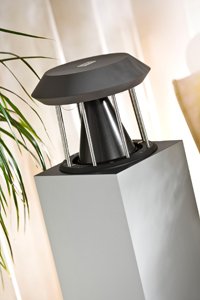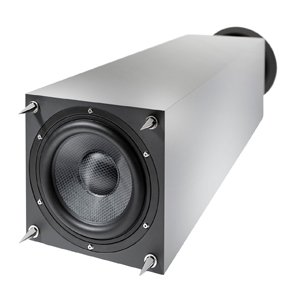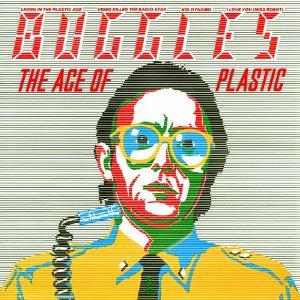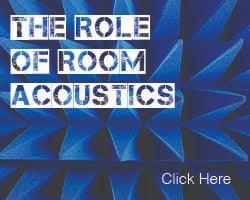Company Background & Speaker Range
To cut a long story short, German Physiks began its commercial life in 1993 to design and market loudspeakers based  on a very innovative driver design created by Peter Dicks. German Physiks are based in Frankfurt, Germany, and the speakers drivers are made and the speakers assembled there. Cabinet manufacture is outsourced.
on a very innovative driver design created by Peter Dicks. German Physiks are based in Frankfurt, Germany, and the speakers drivers are made and the speakers assembled there. Cabinet manufacture is outsourced.
The German Physiks speaker range extends from the 30Kg, £8900 Unlimited Mk2 reviewed here, to the 720Kg, £200,000+ Gaudi II. Woo ! – I’d like to hear that bigg’un – but I wouldn’t like to try and move it!
Individual home-theatre surround speakers are available from 2950 Euros each.
There isn’t a UK distributor as such, but a few select dealers do handle them. If this review sparks your interest – as it should! – initiate contact via the German Physiks website.
Robert Kelly, a member of the German Physiks company, who lives in Cambridge, England, came a-calling to drop off a pair of Unlimited Mk2 speakers for me to review.
A strange name that; Unlimited. I think it originally came from a desire to produce a speaker under the 10,000 Euro price boundary and was originally planned to be limited to a production run of few hundred. However, it proved popular and so was added to the regular German Physiks range and so was then Unlimited. Perhaps that’s the German sense of humour at work!
Genuinely Innovative Technology
The unusual “clever bit” about German Physiks speakers – their USP, the unique selling point, if you will – is an almost-full-range driver, called the DDD (standing for Dicks’ Dipole Driver, after Peter Dicks the inventor). It covers from over 24KHz down to about 200Hz, and (usually*) conventional cone drivers take over from there for the bass region. The DDD driver remains the same throughout the German Physiks range, the size and sophistication of the bass enclosure is the major difference as you increase the price. With the higher end speakers, multiple DDD drivers are sometimes used, and the crossover necessarily becomes more sophisticated, as well.
Actually, the DDD is available in two different forms, made using either thin carbon fibre sheets or titanium foil as originally used for the driver. The carbon fibre driver is far more rugged than the titanium foil implementation – I was shocked to see Robert jab one of the Unlimited II’s carbon fibre DDDs with his finger quite hard with no ill effect; it simply flexed inwards and then returned to its original shape. Do that to the titanium foil driver (or most speaker drivers!) and it will be permanently dented, if not torn.
Sonically, the titanium foil driver is said to have slightly better resolution, but in other respects – bass and treble extension, power handling, ruggedness – the carbon fibre DDD is superior. Both options are available for the same price.
* I said that ‘usually’ conventional cone drivers take over from the DDD for the bass region. There is one interesting exception to this. Just to prove a point that the DDD driver could be used as a genuine full range driver, a horn loaded cabinet was built which extends the carbon fibre DDD’s in-room response down to a healthy 40Hz or so, with some output below that as well. There was so much interest and demand for this that it became a pa rt of the product line, known as the Unicorn, now in Mk2 guise.
rt of the product line, known as the Unicorn, now in Mk2 guise.
Techie overview ….
Bending wave loudspeaker technology. Oh dear, it all gets rather complicated. And I’m not going to try and kid you that I have an in-depth understanding – I don’t; the maths and physics are over my head. But, with considerable help from Robert Kelly, I think I can give you a general guide to what’s happening ….
The driver material is carefully chosen for particular properties. It enables the driver cone to be rigid at low frequencies, when it is working in pistonic mode. As the input frequency rises the cone walls start to flex. As the frequency goes higher, you need to move less air, but faster. With the DDD, the cone’s rigidity breaks down in a fairly major way – this would be disastrous for most speakers, but it is intentional here, and very precisely calculated!. This is the bending wave mode..
To visualise the bending wave, imagine two people holding opposite ends of a long skipping rope. One person flicks their end of the rope and a wave travels along the rope to the other end. What we see with the rope is what we would see if we looked at the DDD driver diaphragm in cross-section. When a sufficiently high frequency is reached, the voice coil imparts such force on the diaphragm so that it is no longer rigid enough to transfer this force down the diaphragm to cause it to move pistonically. Instead, the diaphragm bends and this bending force is transferred along the diaphragm, resulting in a wave that travels from the top to the bottom. This wave on the diaphragm generates a pressure wave we hear as sound.
A major advantage of the bending wave mode is that the voice coil does not have to move the entire diaphragm as it does in pistonic mode. In simple terms, the mass it is moving is its own, plus that of the material in the diaphragm immediately adjacent to it: just as the person who flicks the rope is not moving the entire mass of the rope. Consequently, the moving mass of the DDD driver in bending wave mode is very low, which gives an excellent transient response. The moving mass for the carbon fibre DDD driver in bending wave mode is about 3 grams, which is similar to many tweeters, but its ability to move air is the equivalent to that of a conventional 6.5 inch diameter cone driver.
As the input frequency increases further, a standing wave is eventually set up on the diaphragm surface. At this frequency the driver goes into modal radiation, where vibrating regions that look like the pattern you see when you drop a stone into a pool are formed on the diaphragm’s surface. These get smaller, but more numerous, as the input frequency is further increased, which allows an extended upper frequency limit sufficient for audio purposes.
Peter Dicks, who designed the DDD driver, developed a very detailed computer model of how it worked. This was done by using the results from an initial model to produce a prototype, which he then measured. The measurements were used to further refine the model and this process repeated over several years. He was thus able to determine the properties for the diaphragm material and the physical dimensions that would allow the three modes of operation to be matched together and controlled to produce a driver with a very wide operating range.
Phew! – that’s the techie bit over ….
The bending wave driver cone is mounted vertically, and one outcome of this is that the sound emanates omni-directionally in the lateral plane. You also end up with an almost full range driver acting as an almost point-source, which has to be a good thing.
The ‘entry level’ German Physiks speaker, the Unlimited Mk2, is the subject of this review. Although it is worth bearing in mind that these entry level speakers retail at £8,900 a pair at current UK pricing.
In the Unlimited Mk2 speaker, below about 200Hz an 8 inch (20cm) conventional bass cone driver takes over. This is  mounted at the bottom of the cabinet and faces downward, ensuring a 360 degree dispersion pattern that matches the bending wave driver. Spikes or rubber feet are provided and are essential to provide a gap from the floor which allows the bass frequencies to get out unhindered.
mounted at the bottom of the cabinet and faces downward, ensuring a 360 degree dispersion pattern that matches the bending wave driver. Spikes or rubber feet are provided and are essential to provide a gap from the floor which allows the bass frequencies to get out unhindered.
Basically, they are a slimline square tower with a fancy driver at the top and an 8 inch bass cone at the bottom. The cabinets are of square cross section and less than 9.5 inches (23.5 cm) on a side, and the speakers are 42 inches (106cm) tall, overall. Quite small and slim floorstanders, then.
The inside of the square column is lined with small plastic cells filled with tiny steel ball bearings – these act to dampen the cabinet, and also explain the quite surprising weight of these small-ish speakers.
The Sound
Startling clarity and definition.
A real, tangible insight into the space and acoustic of the recording venue.
Wow.
Fast. Did I say they were fast? Well, they are. Transient edges in the mids and treble are very highly resolved, but not hyped or exaggerated. There’s a feeling of naturalness and relaxation despite the very high resolution on offer.
It’s all very reminiscent of the excellent sound available from my own MBL speakers.
Now there’s an interesting comparison – my MBLs with their Radialstrahler carbon fibre petals for the midrange and top. The technology and underlying physics of sound production are very different – but the low mass of the driver material and the omni-directional principles are similar. And the overall sonic presentation is quite similar, too. Interestingly, Robert Kelly mentioned that MBL are the main competitors for German Physiks.
Sadly, the synergy was not great with my Krell KAV-250a power amp. The Krell has a quite forward and lively character, and the very clean (I dare say that German Physiks would say “accurate”!) and in some ways distinctive tonal presentation of the Unlimited Mk2 made for a quite forward and ultimately tiring combination. Happily, an Onix RA130 integrated amp was with me for review at the same time as the speakers, and the somewhat richer sound from this synergised very nicely indeed with the Unlimited Mk2.
Midrange & Treble ….
Very open, fast and tangible. Remarkably pure and uncoloured. Only from 200Hz downwards is it a conventional ‘cone in a box’ speaker , and it has the lack of boxy colourations that only panel, some open baffle and similar speaker technologies can manage.
Treble is very detailed and nicely extended with just a slight tendency to accentuate vocal sibilance.
A view from the distaff side ….
My wife, as ever, has a good ear and interesting opinions, unfettered by audiophilia. She rated these German Physiks as the best speakers she has heard, after our own MBLs – which retail at over twice the price!
 Compared to our £20k+ MBLs, she found the £9k German Physiks speakers to convey less characteristic distinctiveness on the vocals of our favourite DVD of Gilbert & Sullivan’s operetta, Patience. She also heard a little less resolution, with some fine detail getting lost. And an overall tonally lighter presentation.
Compared to our £20k+ MBLs, she found the £9k German Physiks speakers to convey less characteristic distinctiveness on the vocals of our favourite DVD of Gilbert & Sullivan’s operetta, Patience. She also heard a little less resolution, with some fine detail getting lost. And an overall tonally lighter presentation.
I agree – and it does make me curious about the titanium foil version of the DDD, which is said to address some of these issues!
Bass ….
…. is interesting and rather dependent on musical genre.
I think there is a bit of a recess in energy in the mid-bass, a dip in the perceived frequency response as you go down from the midrange through to the lower bass..
The bass is tight and controlled, vibrant – I think you can definitely hear the benefits of the well damped and rigid bass enclosure.
The wonderful deep bass-line on Melvin Taylor’s bluesy Texas Flood track is as taut as you could wish, and goes surprisingly low for a fairly small speaker. The music positively thrums with controlled, room filling low frequency  energy through the Unlimited II speakers. Taylor’s vocals are clear and focussed – I suspect the slight lack of weight in the mid bass actually improves the perceived clarity of vocals by allowing the midrange to stand out a little.
energy through the Unlimited II speakers. Taylor’s vocals are clear and focussed – I suspect the slight lack of weight in the mid bass actually improves the perceived clarity of vocals by allowing the midrange to stand out a little.
But turn your attention to some classical big orchestral music and things are a bit light-weight and the high frequencies seem accentuated as a result.
If you are spending £9,000 or more on a pair of speakers and have large symphonic works as a priority, then personally I would definitely be looking elsewhere, perhaps further up the German Physiks range. The problem lies with the tonal balance of an orchestra – the foundation of its power and presence lies in the mid- and upper-bass, rather than the low-bass for much rock / funk / dubstep etc.
Rock music, too, has a characteristic flavour. Plastic Age on the album Age of Plastic by The Buggles – a superb and superbly recorded pop album from the early 80s – lacks a little weight and visceral punch. Once again, lower bass is very good, but there is a lack of mid-bass power. Nonetheless, it is amazingly fast, clean and open and brimming with detail – and  perhaps just a little excess fizz at the very top end which tends to highlight sibilance a fraction.
perhaps just a little excess fizz at the very top end which tends to highlight sibilance a fraction.
The dance version of Sinead O’Connor’s track Troy through the German Physiks doesn’t quite capture the full extent of the music’s gut-pounding intensity and drive. It sounds pretty damn good, though! – it’s one of those occasions when, if you hadn’t heard it done better, you would be most impressed indeed. This is pushing these quite small speakers to their limits. Very enjoyable – but there is more to be had.
So … the bass goes surprisingly deep and with very good control, albeit with a lack of power delivery in the mid-bass. If you want genuinely full range speakers, both in terms of low frequency extension and dynamic heft, then I think you’ll be looking elsewhere. The Unlimited Mk2 are a fairly small, slimline floorstander, and although they do well considering, unsurprisingly, that’s how they sound when it comes to bass reach and, especially, low frequency power delivery. But I’d like to try something further up the German Physiks range – my guess is that they are awesome!
Umm, OK, maybe I’ve gone too far here. It’s my experience that a lot of folk are quite happy listening to large music on small speakers; many far, far smaller than the Unlimited Mk2. To me it can just sound squeaky – but hey, those folk are happy, so what do I know?!
I’m not here to impose my tastes on you, just to try and describe what they do – and they do one hell of a lot right, even in the bass department – try them and see if they do it for you.
Dynamics and loudness levels ….
Along with the afore-mentioned transient speed comes a naturalness and ease in the tracking of dynamic changes.  When called for, dynamics can be appropriately explosive – the blink-inducing startle factor of Eddy Louiss’s Blues for Klook track was well caught – ‘fast and loud’ is needed here, and so many speakers simply can’t manage this at all convincingly.
When called for, dynamics can be appropriately explosive – the blink-inducing startle factor of Eddy Louiss’s Blues for Klook track was well caught – ‘fast and loud’ is needed here, and so many speakers simply can’t manage this at all convincingly.
And they go loud – certainly louder than I wished to explore in my 4×6 metre room. For much larger listening spaces, German Physiks simply increase the number of DDD drivers along with an appropriate increase in bass frequency handling capacity. For example, each top of the range Gaudi II has 4 DDDs and a very impressive array of bass drivers.
Soundstaging ….
Uh! Just wonderful. Like my MBLs, they throw out a palpably atmospheric and open rendition of the acoustic space. And contrary to what many folk seem to expect from an omni, they focus like demons when it comes to individual musical images within the wide open soundstage. I honestly don’t think you’ll hear the like of the German Physiks and MBL soundstaging and imaging capabilities from most other loudspeaker technologies. It has to be heard to be understood, and afterwards anything else can seem like second best.
Positioning ….
They are genuine omnidirectional speakers – it really doesn’t matter which way they are pointing!
Positioning relative to the wall and other items is quite important, they do like a bit of space around them. I’d recommend 3 feet (1 metre) as a minimum, well OK, maybe you aren’t losing much with a 2 feet (65cm) clearance. If you can’t achieve that then you aren’t really letting them strut their stuff.
They sounded good (very good!) just plonked on my carpeted floor with their rubber footers. I didn’t find the sound with the supplied spikes fitted to be noticeably different.
Conclusions
This is a very revealing, genuinely high resolution speaker technology and, as ever, system synergy is vital – so be sure to experiment a little with component choice. For my tastes, my Krell amp was not a happy match – the Onix RA130 worked very much better.
But let’s cut to the chase – are the Unlimited Mk2 speakers worth the not inconsiderable sum of £8,900? Well, that, as ever, is up to you. It’s your money, you have to decide.
Bass and the overall dynamic envelope are limited; you can certainly get a larger scale presentation for a lot less expenditure.
But that’s missing the point.
Perhaps the question is better phrased as “Can you duplicate what they do best, for less?”. I doubt it, certainly not in my experience. Going back to the MBL comparison, the cheapest MBL speaker, a smallish standmount, is significantly more expensive – which kind of makes the German Physiks Unlimited Mk2 look like good value for money!
Focal, B&W, Tannoy, Wilson, Harbeth and oh so many others all make some very fine speakers in the same price bracket – but, in a similar kind of way to MBL, German Physiks do it differently. They offer a real alternative approach to the ‘price competition’, providing a different balance of capabilities, and they should definitely be on the audition list for anyone looking for loudspeakers at their price point.
You may prefer them, you may not – but they are a genuine and genuinely different, alternative – and you owe it to yourself to try them out.
There – that told you!
I like them. A lot.
What I can say for sure is that if German Physiks had had a significant hifi show presence in the UK alerting me to their existence, then MBL would have had serious competition for my own money! For me, you cannot get a higher recommendation than that.
Recommended – with enthusiasm!
______
Review system: MBL 116F speakers, Krell KAV-250a power amp, Glasshouse and Tisbury Mini Passive pre-amps, Onix RA130 amp, McCormack UDP-1 universal disc player. RFC Pluto & Oscar’s Audio Dark Knight i/c and Cable Talk Symphony 3 speaker cables.



















































































































































































































Hi Jerry
Would you not conclude that an amplifier in a higher price bracket with better synergy than the Krell would have changed your opinion on the overall presentation?
@Dan
Thanks for your question!
I tried the speakers with 3 amps, in fact, and the overall presentation remained similar – all 3 showed the mid bass dip which concerned me and seemed to be the main compromise inflicted by small size and whatever cost constraints were required to keep the rrp below the 10k Euro threshold. The Krell amp fared noticeably worst, because of its somewhat forward and excitable (and exciting!) nature. This was definitely a case of 2 wrongs NOT making a right!
(The Krell sounds fabulous with my MBLs, by the way!).
I’m quite satisfied that I have reported on the true overall capability of the speakers. But sure, spend more on an amp and you should expect superior results – otherwise you have wasted your money!
I”ve been looking forward to reading your review since hearing these at Munich 2013. I really liked them then and it is good to hear what you thought in comparison with the MBLs, nice one!
Hello Jerry, On behalf of all at German Physiks we would like to thank you for a very thorough and perceptive review. Your review is especially relevant, as your extensive experience with the excellent MBLs means that you are very familiar with omnidirectional loudspeakers and so are ideally positioned to explain the important differences between omnis and conventional designs. Hopefully at some point in the future I will be able to bring a pair of our Borderlands for you to try out. They use the same DDD driver as the Unlimited, but have a much bigger bass system, so can go a lot deeper.
On behalf of everyone at German Physiks I would like to thank Janine for a very informative review. I know she put a lot of time and effort in to this and we are very grateful. She went to great pains to understand how the DDD driver worked and as a result has been able to describe clearly what is special about the HRS-130. Most importantly she has talked about how it plays music, rather than concentrate too much on the technology, interesting though it may be. I have been in the audio industry nearly 30 years and have dealt with reviewers in the UK, USA and Far East. I have met very few with Janine’s knowledge and experience of music, recording and audio technology. HiFi Pig, please give us more reviews from Janine and make sure you keep her. Burn her passport if necessary!
Robert Kelly
German Physiks